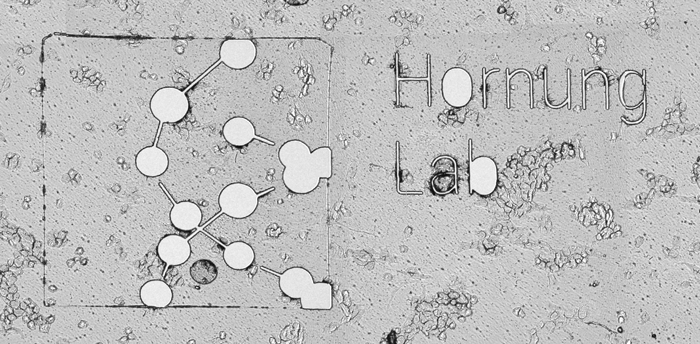Hornung Lab - Research
- Research
- Nucleic acid sensors
- Inflammasomes
- Genome Engineering
Genome engineering in immune cells
Over the past decade, a number of major breakthroughs have reshaped the landscape of genome engineering. Among these is the advent of the CRISPR/Cas system, which has opened the door to custom modification of genomic architecture in multiple cell types. Our laboratory has been at the forefront of adopting these technologies, using CRISPR/Cas-based genome engineering to deepen our understanding of innate immune sensing and signaling cascades. To this end, we have established several CRISPR/Cas-based workflows in the lab:
Knockout cell generation
A major focus of our efforts is the generation of knockout cell lines. This is achieved by precisely targeting and disrupting a critical exon of the gene of interest, introducing indel mutations that can potentially lead to the formation of premature stop codons, degradation of the corresponding mRNA via nonsense-mediated mRNA decay, or the formation of truncated proteins.
To facilitate our research, we have developed robust workflows for various cell lines that allow the generation of single cell clones after the gene targeting process. This is primarily achieved by limiting dilution cloning, a process we have largely automated using our advanced liquid handling workstations. Clone selection is followed by extensive automated analysis. Identified clones are duplicated and a sample is lysed for a series of PCR analyses, culminating in deep sequencing. The sequencing data is then mined to identify clones with all alleles disrupted by frame-shifting indel mutations.
We've expanded our toolkit beyond plasmid- or lentivirus-based systems to include ribonucleoprotein (RNP)-based systems. In this technique, a recombinant Cas9 protein is delivered into cells in tandem with a synthetic guide RNA. This approach not only increases targeting efficiency, but also allows us to manipulate cell types that are typically resistant to plasmid or lentivirus delivery, such as primary human T cells or hematopoietic stem cells.
Forward genetic screens
As a complement to our hypothesis-driven knockout projects, we also perform forward genetic screens, where cells are selected based on phenotypic interest. To facilitate this, we use genome-wide libraries targeting both the mouse and human genomes. We perform screens that select for a range of phenotypes, from cell survival to complex traits such as specific cell death phenotypes or surface markers.
While microscopy can provide a wealth of information on various aspects of cellular composition, its full potential in genetic screening remains largely unexplored. This is primarily because large-scale isolation and genotyping of visually distinctive cells has been challenging. To unlock this potential, we have recently developed Spatially Resolved CRISPR Screening (SPARCS) in collaboration with the Matthias Mann group (MPI Biochemistry). SPARCS is a platform for microscopy-based genetic screening specifically designed for spatial cellular phenotypes. It uses automated high-speed laser microdissection to isolate phenotypic variants in situ from large library sizes. A major advantage of SPARCS is its compatibility with high-end microscopy setups and the ability to analyze the image of the genetically perturbed cells "off-line" using state-of-the-art image analysis tools (e.g., deep learning image analysis). It also provides access to the entire image dataset for unbiased phenotype detection and the ability to revisit and re-analyze archived screens.

Image courtesy of Niklas Schmacke
Recent publications in this area:
SPARCS, a platform for genome-scale CRISPR screening for spatial cellular phenotypes.
Schmacke NA, Mädler SC, Wallmann G, Metousis A, Bérouti M, Harz H, Leonhardt H, Mann M, Hornung V.
bioRxiv 2023.06.01.542416; doi: 10.1101/2023.06.01.542416.
bioRxiv
Rapid, efficient and activation-neutral gene editing of polyclonal primary human resting CD4(+) T cells allows complex functional analyses.
Albanese M, Ruhle A, Mittermaier J, Mejías-Pérez E, Gapp M, Linder A, Schmacke NA, Hofmann K, Hennrich AA, Levy DN, Humpe A, Conzelmann KK, Hornung V, Fackler OT, and Keppler OT.
Nat Methods. 2022. doi: 10.1038/s41592-021-01328-8.
Pubmed
CRISPaint allows modular base-specific gene tagging using a ligase-4-dependent mechanism.
Schmid-Burgk JL, Höning K, Ebert TS, and Hornung V.
Nat Commun. 2016. doi: 10.1038/ncomms12338.
Pubmed
Designer Nuclease-Mediated Generation of Knockout THP1 Cells.
Schmidt T, Schmid-Burgk JL, Ebert TS, Gaidt MM, and Hornung V.
Methods Mol Biol. 2016. doi: 10.1007/978-1-4939-2932-0_19.
Pubmed
Synthesis of an arrayed sgRNA library targeting the human genome.
Schmidt T, Schmid-Burgk JL, and Hornung V.
Sci Rep. 2015. doi: 10.1038/srep14987.
Pubmed
Ligation-independent cloning (LIC) assembly of TALEN genes.
Schmid-Burgk JL, Schmidt T, and Hornung V.
Methods Mol Biol. 2015. doi: 10.1007/978-1-4939-1862-1_8.
Pubmed
OutKnocker: a web tool for rapid and simple genotyping of designer nuclease edited cell lines.
Schmid-Burgk JL, Schmidt T, Gaidt MM, Pelka K, Latz E, Ebert TS, and Hornung V.
Genome Res. 2014. doi: 10.1101/gr.176701.114.
Pubmed
A ligation-independent cloning technique for high-throughput assembly of transcription activator–like effector genes.
Schmid-Burgk JL, Schmidt T, Kaiser V, Höning K, and Hornung V.
Nat Biotechnol. 2013. N/A.
Pubmed

